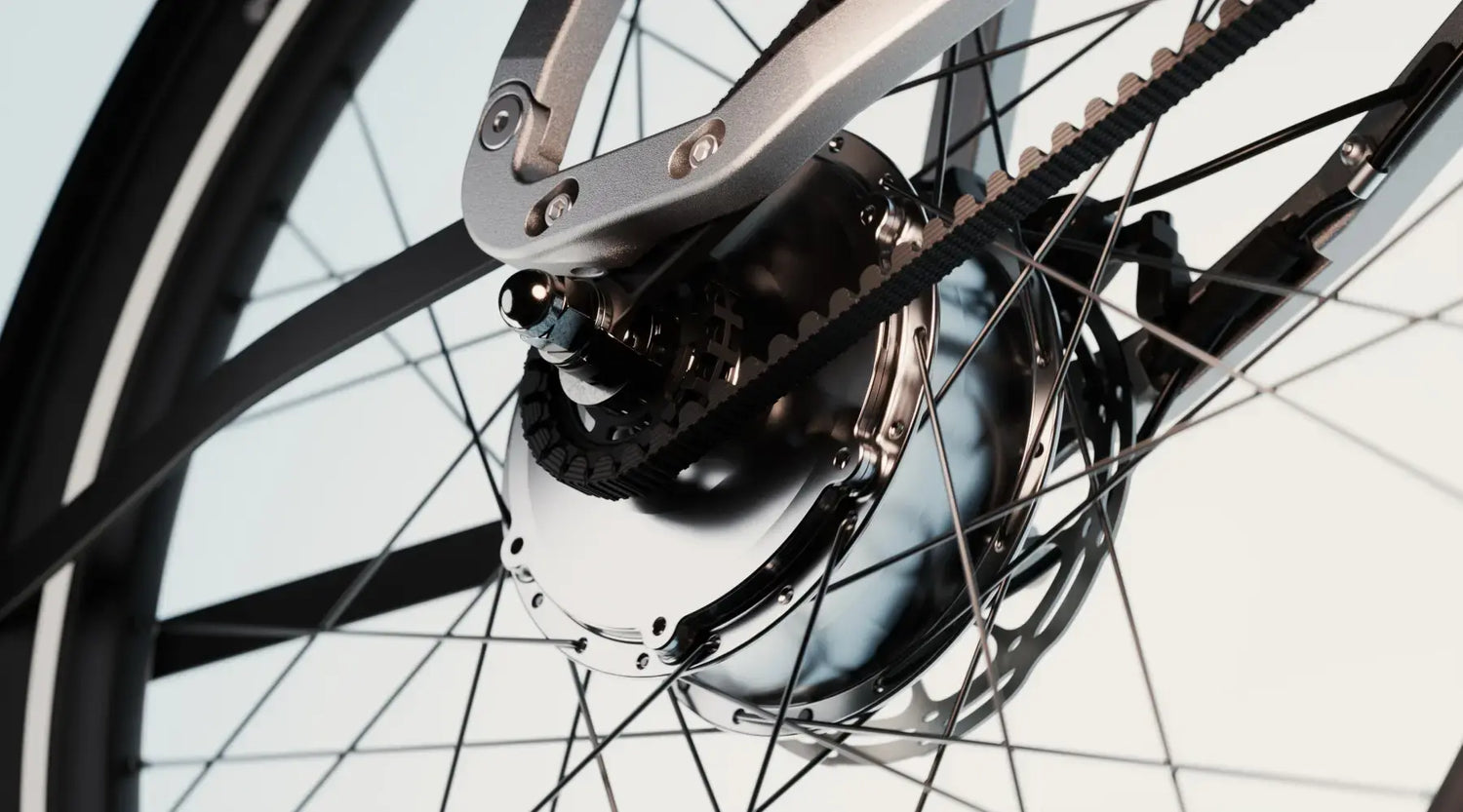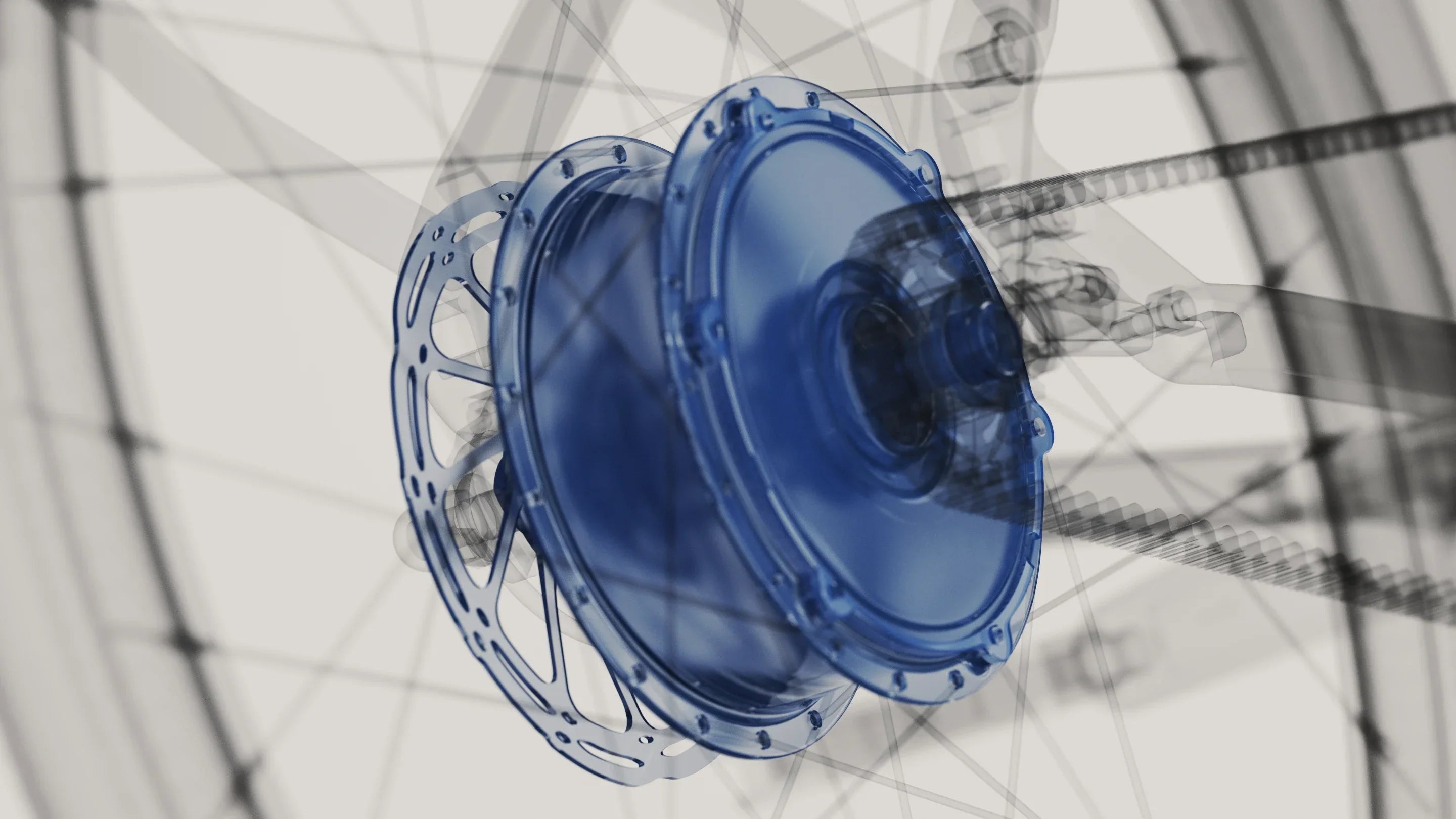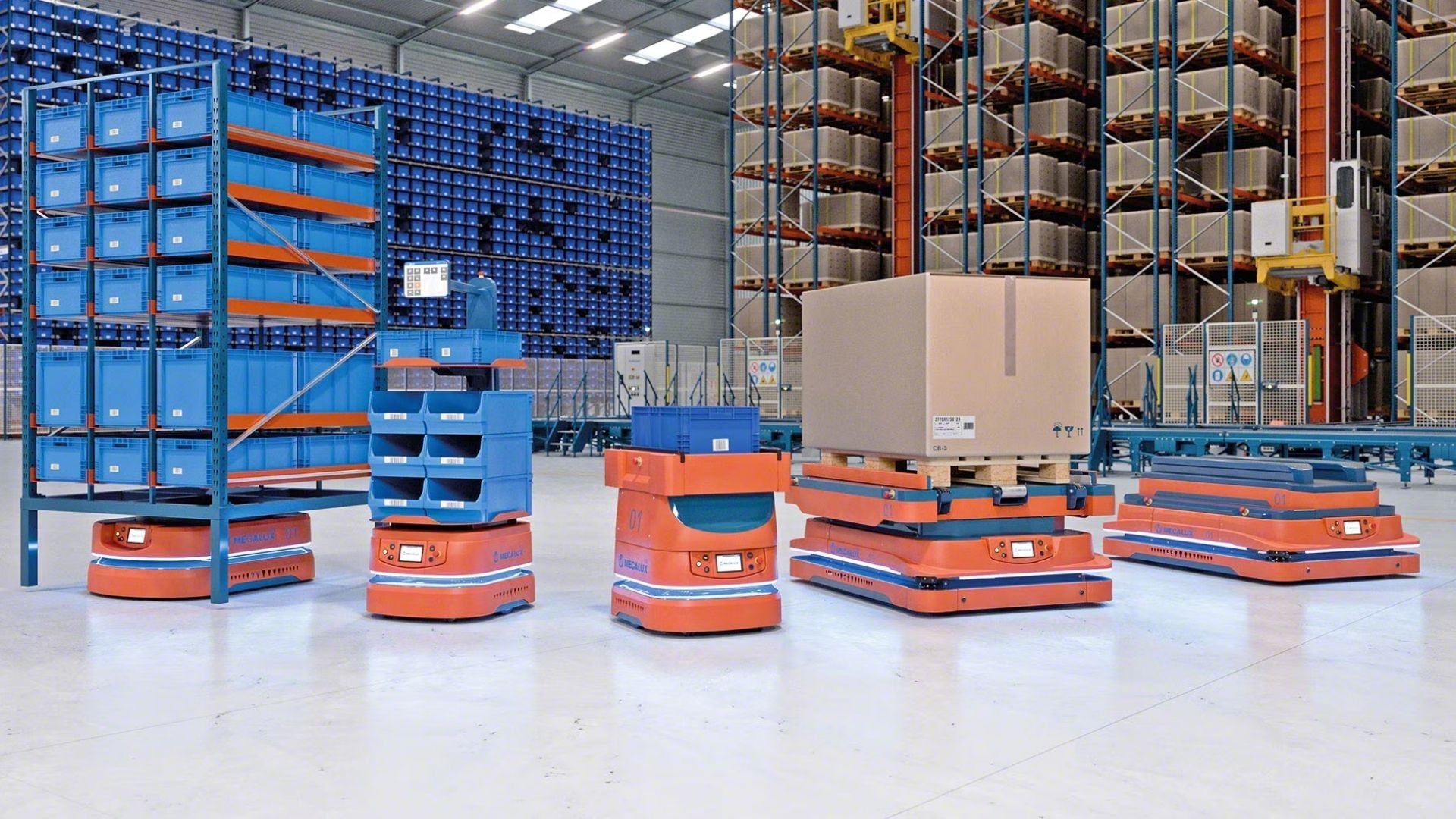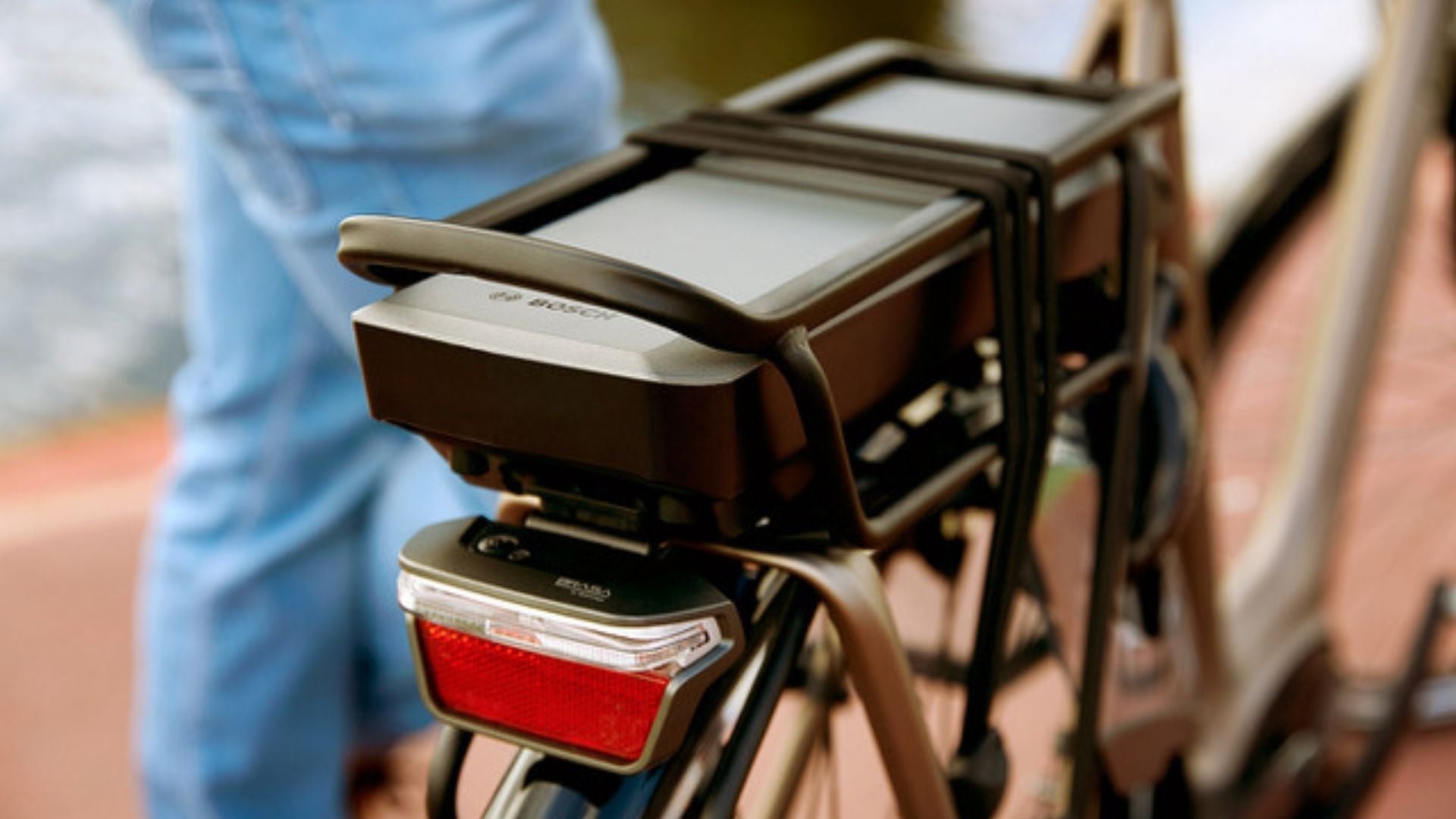Choosing the right motor is a key component of the electric bike user experience. The motor plays a crucial role in the overall performance of the bike , influencing speed, power, the feel of the assistance, and battery life. It is therefore essential to research the different options available on the market to find the one that best suits your needs and preferences. Some of the most popular and innovative motors currently available include brands such as Bosch, Shimano, Bafang, Yamaha, and more. These renowned brands offer high-quality motors that provide smooth and efficient pedal assistance.
The 4 main types of electric bicycle motors
There are different types of motors, depending on their position on the bike. Each type offers advantages and disadvantages, which we will present to you.
Mid-engine
A commonly cited type of motor is the mid-drive motor. This motor, also known as a mid-drive motor, is positioned at the bottom bracket. It replicates the natural pedaling motion of the legs through the bike's drivetrain. This motor stands out for its ability to avoid any resistance when pedaling without using the battery. This allows the bike to function identically to a traditional bicycle.
Benefits :
- This type of engine is very suitable for tackling hills
- Some motors are integrated almost invisibly into the frame, which is attractive to aesthetically conscious riders.
- It is located in the center of the bike, which provides better weight distribution.
Disadvantages:
- This type of powerful engine can quickly become quite noisy due to its multiple interactions with the transmissions.
- A more difficult engine to install and repair, as it requires a specifically designed frame to accommodate it, which can limit customization options and increase maintenance and purchase costs.
- This type of engine is among the heaviest
Front wheel motor
Bicycles with a motor in the front wheel, also called a hub motor, are generally designed for short-distance travel on flat terrain. They are among the most common models. These motors are also known as front hub motors. On this type of e-bike, propulsion is forward, which can feel like a slight pull, but the weight of the motor is usually offset by the (often substantial) weight of the battery, usually located at the rear.
Benefits :
- Front wheel motors are often easier to install, as they do not require major modifications to the bike frame.
- On flat or slightly inclined surfaces, these motors provide sufficient traction for stable driving.
- For cyclists used to traditional bicycles, the driving sensation with a front wheel motor is not disorienting for those used to traditional bicycles, as it does not radically change the driving dynamics.
Disadvantages:
- On slippery surfaces or uphill, traction can be compromised since the rider's weight is at the rear, reducing pressure on the front wheel.
- The power of the front wheel motor can sometimes give a feeling of front pull, which can affect the handling of the bike, especially in tight corners.
- When descending, weight distribution can make steering less precise, requiring increased vigilance from the rider to maintain control.
Rear wheel motor
A rear-wheel motor is a type of motor integrated directly into the rear wheel of an electric bike. Unlike a mid-mounted motor, it does not transmit power from the motor to the wheel via the chain, but instead uses an integrated hub system that drives the wheel. When the rider begins pedaling, a sensor detects the movement and activates the motor to provide electric assistance.
Benefits :
- Traction is improved on slippery surfaces or when climbing because the rider's weight is naturally over the rear wheel.
- The start is immediately boosted by the rear wheel motor, as it is directly synchronized with the pedaling when equipped with electric assistance. This guarantees a smooth and harmonious riding experience.
- The weight distribution promotes better stability and downhill handling, providing increased control in corners and demanding situations.
- It places less stress and wear on the transmission parts, chain and cassette, than a conventional bicycle, which increases its lifespan.
- This engine is more responsive, as it is directly connected to the rear transmission, which may particularly appeal to fans of dynamic driving.
Disadvantages:
- The rear wheel motor adds weight to the rear of the bike, which can affect balance and handling, especially at low speeds.
- With its rear-mounted position, this motor can create inertia at start-up and a less dynamic response when pedaling. This configuration can impair the smoothness of the assistance. However, some models manage to avoid this problem by integrating a torque sensor.
Energy recovery engine

Finally, motors with an energy recovery function. Combined with supercapacitors, it allows the recovery of kinetic energy produced during braking, descent and wheel rotation.
Unlike what usually happens, where this energy is dissipated in the form of heat, here it is converted into electrical energy and stored either in the bicycle battery or in supercapacitors (more efficient storage, because it avoids too sudden variations in charge on the battery).
This system maximizes the bike's energy use and extends its range. It's worth noting that most electric-assisted bicycles (EABs) on the market don't have this energy recovery feature. This is partly because the widely available central motors don't usually include this feature. Therefore, to benefit from energy recovery, you need to opt for a bike equipped with a hub motor, often mounted in the rear wheel.
Benefits :
- They are environmentally friendly, thanks to their ability to recover the kinetic energy produced during braking.
- Rear motors on hybrid electric bikes offer the best energy efficiency by facilitating energy recovery, which helps optimize the use of available energy.
- This energy recovery increases the battery's range, especially during descents where the bike produces more energy than necessary.
Disadvantages:
- Although this rear drive offers greater charging capacity, it is often too inefficient, except in the case of high-performance bikes equipped with supercapacitors.

Top Electric Bike Motor Brands
There are many different engine brands in the cycling world today, the main ones to know are:
- Bosch Motor : Bosch is a long-standing motor manufacturer renowned for its e-bike motors, particularly for its mid-drive motors. Their motors are manufactured in Hungary and have a reputation for being powerful and robust.
- Bafang Motor : Bafang is a Chinese brand offering a wide range of motors for electric bikes. Produced in China, Bafang motors are known for their ability to provide robust assistance, making them a popular choice for cyclists looking for a good range.
- Shimano Motor : Shimano e-bike motors are renowned for their lightweight design, specifically suited to rough and rugged terrain, especially for mountain bikes. The Japanese company has developed its technologies to meet the demands of cyclists, dispersing its production across Asia and the United States. Shimano emphasizes the discretion of its electric assistance as well as the simplicity of its motors' operation.
- Anod motor : entirely made in France, they stand out from their competitors due to their configuration. The brand favors installing the motor at the rear rather than in the center of the bike. This choice ensures increased lightness, better ease of maintenance, but above all, it allows kinetic energy to be recovered and transformed into electrical energy. This approach aligns with the stated objective of maximizing efficiency and synergy in the hybridization of different bicycle technologies.
- Virevolt Motor : Another exclusively French brand, Virevolt specializes in converting conventional bicycles into electric bikes using motor kits designed for professionals and manufacturers. The brand's components and batteries are manufactured in China and around the world, then assembled locally in France.
Understanding Electric Bike Motor Power
When choosing an electric bike, it's essential to understand the differences between different motor types. In addition to the motor types detailed below, a key differentiator between brands is the motor's power, expressed in watts. Most electric bike and pedelec motors offer a standard power output of 250 watts. However, some models offer more powerful motors. But be careful! It's crucial to note that French law limits the power output of electric bikes to 250 watts. Any motor exceeding 500 watts classifies the vehicle as a different class of moped, disqualifying it from being used on cycle paths and requiring specific registration. This restriction does not apply to electric bikes. Therefore, be careful not to be misled by brands offering super-powerful 3,000-watt motors for an electric bike.
Choice of engine according to your needs
Choosing the right motor for your electric bike will depend on your intended use. It's essential to consider factors such as the motor's power, range, and fuel efficiency to ensure you choose the one that best suits your needs.
-
If you plan on mainly city riding and daily use, a mid-power engine might be enough to help you navigate busy streets with ease.
-
If you plan to go off-roading (ATV), a more powerful and robust engine will be needed to tackle rough terrain.
- For long distances, it is recommended to choose an engine with low consumption so as not to be caught off guard along the way.
High-power electric bicycle motors
These motors are designed to provide additional assistance to cyclists, especially on difficult terrain or for longer journeys. The higher power makes it easier to climb steep slopes and maintain a constant speed even in demanding conditions. The suitability of these motors will greatly depend on the type of use you plan to use them for. For example, if you intend to mountain bike or carry heavy loads, a 3000W electric bike motor might be more suitable. On the other hand, for more urban use or shorter journeys, a 1000W electric bike motor might be more than sufficient (a 250W limit is imposed in France).
The adaptable motor for electric bikes
Convert your traditional bike into an electric bike with the adaptable motor options available on the market. Electrifying a traditional bike can be a cost-effective solution. Here are the available options:
- Front or Rear Wheel Conversion Kit: These bike electrification kits include an electric motor, battery, controller, and pedal sensor, all installed on an existing front or rear wheel.
- Crankset Conversion Kit: These kits replace your bike's crankset and arms with a set that includes an electric motor, pedal sensor, and battery.
- Front or rear wheel hub motor: These motors are integrated into the hub of the bicycle's front or rear wheel, providing electric assistance directly to the wheel.
Electric Bike Motor Price Comparison
It is essential to carefully compare the different options available and take the time to think before making a purchase.
Front or Rear Wheel Motor
If you're on a budget and want an entry-level solution to electrify your bike, a front or rear wheel conversion kit may be a good choice. Front or rear wheel conversion kits can cost between €200 and €800 depending on the brand, motor power, and included features.
Pedal Motor
If you're looking for better weight distribution and a more natural ride feel, a bottom bracket conversion kit may be a good option. Bottom bracket conversion kits can cost between $400 and $1,500 depending on the brand, motor power, and included features.
The engine of the Anod product Innovation and efficiency
Anod opted to position the motor in the rear wheel for its Anod Hybrid model, a decision motivated by the ease of implementing the energy recovery system there. Anod's MHR1 motor stands out for its discretion and power, but what makes it truly unique is its regenerative motor technology. This innovation converts kinetic energy into electricity, which is stored and redistributed within the bike by supercapacitors to support the battery.
The advantage of combining a battery with a regenerative motor and supercapacitors is the ability to benefit from electric assistance even if the battery is flat. With a torque of 60 Nm (equivalent to 110 Nm for a mid-drive motor), it offers performance suited to steep slopes and improved pedaling responsiveness.
This hybrid model has benefited from 7 years of research to deliver a powerful, efficient, and low-maintenance product. Even in the event of a breakdown, maintenance is simplified thanks to the easy replacement of the rear wheel. By choosing the Anod motor, you have access to advanced technology that guarantees optimal performance, increased reliability, and remarkable durability. Book a test drive now to experience this technology for yourself.
Conclusion
Each motor has its own unique characteristics and performance, so choosing the best one for your electric bike is essential to optimize your riding experience. A motor that's suited to your needs will provide a more enjoyable and efficient riding experience.
For more information, you can consult our article which explains how an electric bike works .
Take the time to compare the different options available on the market and don't hesitate to come and test the Anod engine via a reserved test drive to see if it meets your needs and expectations. However, we recommend that you form your own opinion: book a test drive of the Anod Hybrid.
FAQ
Which is the best motor between Bosch, Yamaha, Shimano, Bafang and Anod for an electric bike?
It depends on your needs! If you're primarily looking for speed and power, choose a motor that's proven on mountain bikes or touring bikes.
If you're looking for a balance of power and comfort for urban commuting, the Anod Hybrid is a great choice. This rear motor, combined with a small, lightweight 650g battery, makes power management easier and eliminates the need to carry a bulky battery. To learn more about electric bike batteries , check out our article on the subject.
Is it possible to convert a normal bicycle into an e-bike?
Yes, absolutely! You can extend the lifespan of your bike or improve its performance by installing an electric motor. Electrification kits are available from various brands to simplify this process. However, keep in mind that you'll get better performance from a bike whose components have been optimized for its motor. In the case of the Anod Hybrid, for example, the entire bike was designed around its motorization and energy recovery system.
What is the lifespan of an electric bicycle motor?
The lifespan of an electric bicycle motor varies depending on the manufacturer, but in general, these motors can last several decades with average use (less than 30,000 km per year). Under optimal conditions, a motor can remain functional for between 15 and 20 years.
How much power does an electric bike motor need?
The power of an electric bike motor is expressed in watts (W). In France, regulations limit this power to 250W. If this limit is exceeded, the vehicle is no longer considered a bicycle, but rather a speed bike, which implies additional obligations, such as insurance and registration. Therefore, if you are considering purchasing an electric bike in France, be wary of international websites that offer 3000W models. Don't risk receiving a fine if you discover that your machine is prohibited on cycle paths.







